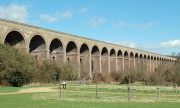Difference between revisions of "Chappel Viaduct"
(Created page with "The Chappel viaduct is 1,066 feet long, has 32 arches of 30 feet span and its maximum height is 75 feet. It currently takes the Marks Tey to Sudbury branch line, which connects...") |
|||
| Line 1: | Line 1: | ||
[[Image:Im2010Wik-ChappelVia.jpg|thumb| Chappel Viaduct. ]] | |||
The Chappel viaduct is 1,066 feet long, has 32 arches of 30 feet span and its maximum height is 75 feet. | The Chappel viaduct is 1,066 feet long, has 32 arches of 30 feet span and its maximum height is 75 feet. | ||
Latest revision as of 20:21, 2 January 2011
The Chappel viaduct is 1,066 feet long, has 32 arches of 30 feet span and its maximum height is 75 feet.
It currently takes the Marks Tey to Sudbury branch line, which connects regularly with trains to and from London's Liverpool Street Station.
The large number of construction workers needed for the project were housed, many with their families, in temporary huts built on Wakes Colne Green. Although some 5 or 6 million bricks are reckoned to have been used, the piers were hollow to save money and reduce weight.
A further remarkable feature of the viaduct is that it is built on a gradient - the Sudbury end is 9.5 feet higher than the Marks Tey end.
According to William White’s History, Gazetteer and Directory of the County of Essex, 1848, the first stone was laid in September 1847. The viaduct took two years to build, and is thought to be the second largest brick-built structure in England.
The first passenger train to Sudbury, carrying an official party from Colchester, ran on 2 July 1849.
See Also
Sources of Information
- [1] Wikipedia


